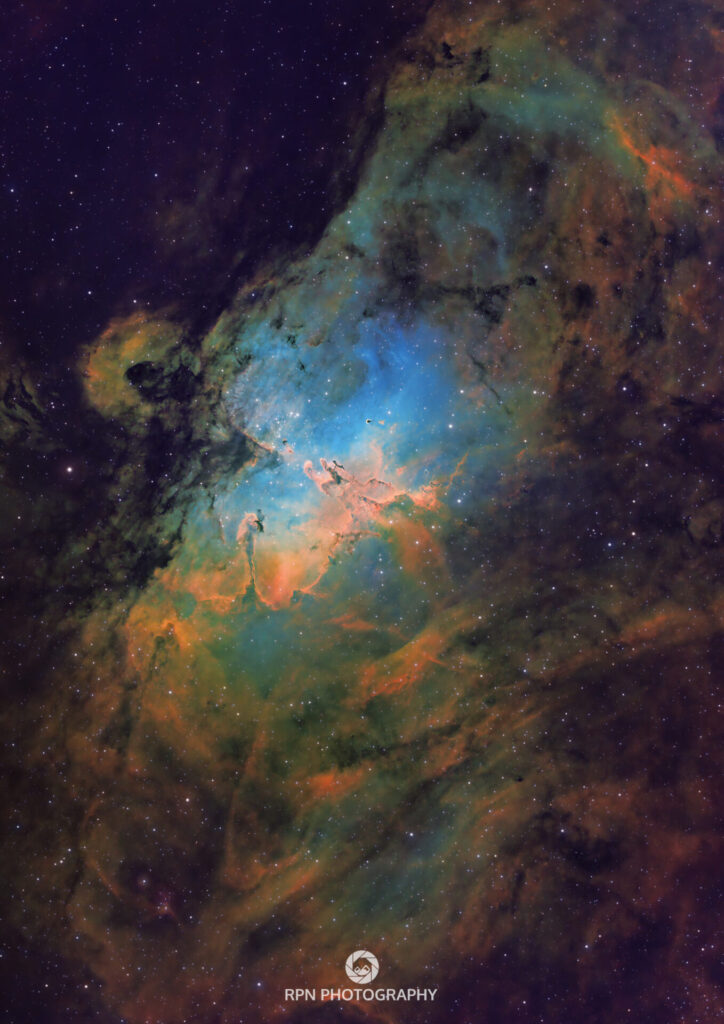The BV’s astrophotographer Rob Nolan is back – and counting the days to those long winter nights
Well, what can we say about the British Summer holidays so far? Not a lot that’s good!
I had such high aspirations for warm nights of observations, with clear sunny skies for some solar imaging, too. Alas, neither has so far come to fruition. Hopefully the weather will improve as we move through the month.
As we wait for the longer nights, there’s a target that I last captured in 2021. It peeks above the horizon and is best seen during the month of July here in the UK. The Eagle Nebula in the Serpens constellation is famously home to the Pillars of Creation, that astounding image many of us recognise instantly which was taken by the Hubble space telescope back in 1995.
It’s a target I’ve shared before in this column, the use of my newer mono camera and scope means that I’ve been able to capture far more detail this time around, and also represent the different gases using what’s known as the ‘Hubble palette’, showing off the amazing emission nebulas in glorious golden reds, greens and blue (representing sulphur, hydrogen and oxygen).
The Eagle Nebula itself is roughly 7,000 light years away from Earth and is known as a stellar nursery, due to the amount of newborn stars being created from the abundance of gases. Stretching roughly four to five light years, the Pillars of Creation are a fascinating but relatively small feature of the entire Eagle Nebula, which itself spans approximately 70 by 55 light years.
If you’re on a tablet or phone, rotate to see the image in landscape orientation – you’ll be able to easily make out the huge eagle shape of the nebula, including the head and wings. Personally though, with the detail we can now more readily reveal, I think I it looks much more like a dragon! It’s a target I’ll never get bored of imaging, and I just hope I can get some more time on it next year.
This month’s image was captured with my 1000mm Maksutov Newtonian Telescope and the ZWO ASI2600MM Pro Astro camera with Narrowband filters – it’s about 4.5 hours of data.
The night sky, August 2023 – Rob’s guide for your stargazing this month:
This month we’ll be treated to a festival of various celestial events – if the cloud will give way like stage curtains to reveal the grand show! There is so much to observe this month.
Starting with the Milky Way Arch itself, which begins to reveal itself beautifully as the darker nights return. You’ll easily be able to find three bright shining stars in our glowing galaxy band –Vega, Deneb and Altair. These stars mark out the verticals of what’s known as the Summer triangle.
Closer to home, we’ll be treated to two supermoons this month, the second of which is the brightest full moon of the year.
Saturn also reaches opposition this month, meaning it’s the best time to observe this beautiful planet and its rings as it’s the closest it will come to Earth this year.
Starting at the beginning of the month, the first supermoon was on the 1st of August – and we all missed it due to the British weather! But fear not, we get another chance on the 31st to witness a Blue Supermoon, the biggest supermoon of the year. Don’t miss it! You’ll need to set your alarm clock – the Moon will peak at 2.35am.
Over the upcoming weekend of the 8th, look to the Moon to see Jupiter hanging to the right. On the 9th, The Pleiades will join the stage alongside the Moon and Jupiter to create a pleasing trio.
The major event of the month is the night of the 12th/13th – we’ll witness the climax of the Perseid meteor shower. This year it’s due to be a great show for observing, so lets cross our fingers for good clear skies!
These prolific shooting stars (actually dust from comet Swift-Tuttle) will be burning up high above our heads in what is usually the best annual meteor shower that we’re invited to.
Finally, on the 31st, that biggest Supermoon of the year. It’ll be 30 per cent brighter than the faintest Full Moon we observe, so it wont be a blinding ball of rock in the sky, but it will still be an impressive sight. While you’re there, you’ll see Saturn hanging out close to our shining Lunar beacon.
Next month , we’ve got an exciting expedition returning to Earth from space, and also the Autumn Equinox. Until then, Clear Skies!


